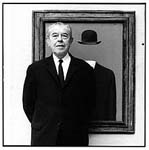Rene Magritte

René François Ghislain Magritte (21 November 1898 – 15 August 1967) was a Belgian surrealist artist. He became well known for a number of witty and thought-provoking images. Often depicting ordinary objects in an unusual context, his work is known for challenging observers' preconditioned perceptions of reality. His imagery has influenced pop, minimalist and conceptual art.
Magritte's work frequently displays a collection of ordinary objects in an unusual context, giving new meanings to familiar things. The use of objects as other than what they seem is typified in his painting,The Treachery of Images (La trahison des images), which shows apipe that looks as though it is a model for a tobacco store advertisement. Magritte painted below the pipe "Ceci n'est pas une pipe" ("This is not a pipe"), which seems a contradiction, but is actually true: the painting is not a pipe, it is an image of a pipe. It does not "satisfy emotionally"—when Magritte was once asked about this image, he replied that of course it was not a pipe, just try to fill it with tobacco.
Magritte used the same approach in a painting of an apple: he painted the fruit and then used an internal caption or framing device to deny that the item was an apple. In these "Ceci n'est pas" works, Magritte points out that no matter how naturalistically we depict an object, we never do catch the item itself.
Among Magritte's works are a number of surrealist versions of other famous paintings. Elsewhere, Magritte challenges the difficulty of artwork to convey meaning with a recurring motif of an easel, as in his The Human Condition series (1933, 1935) or The Promenades of Euclid (1955) (wherein the spires of a castle are "painted" upon the ordinary streets which the canvas overlooks). In a letter to André Breton, he wrote of The Human Condition that it was irrelevant if the scene behind the easel differed from what was depicted upon it, "but the main thing was to eliminate the difference between a view seen from outside and from inside a room."[17] The windows in some of these pictures are framed with heavy drapes, suggesting a theatrical motif.[18]
Magritte's style of surrealism is more representational than the "automatic" style of artists such as Joan Miró. Magritte's use of ordinary objects in unfamiliar spaces is joined to his desire to create poetic imagery. He described the act of painting as "the art of putting colors side by side in such a way that their real aspect is effaced, so that familiar objects—the sky, people, trees, mountains, furniture, the stars, solid structures, graffiti—become united in a single poetically disciplined image. The poetry of this image dispenses with any symbolic significance, old or new."[19]
René Magritte described his paintings as "visible images which conceal nothing; they evoke mystery and, indeed, when one sees one of my pictures, one asks oneself this simple question, 'What does that mean?'. It does not mean anything, because mystery means nothing either, it is unknowable."[20]
Magritte's constant play with reality and illusion has been attributed to the early death of his mother. Psychoanalysts who have examined bereaved children have hypothesized that Magritte's back and forth play with reality and illusion reflects his "constant shifting back and forth from what he wishes—'mother is alive'—to what he knows—'mother is dead' ".
From Wikipedia, the free encyclopedia
